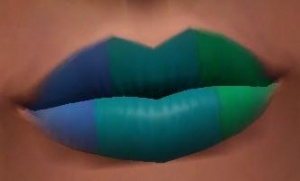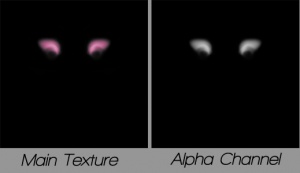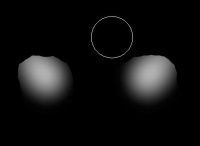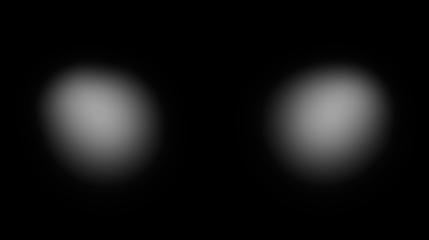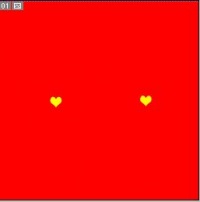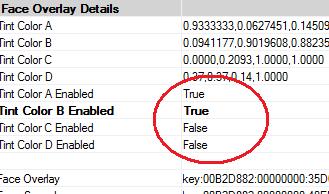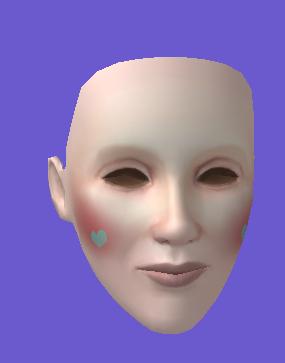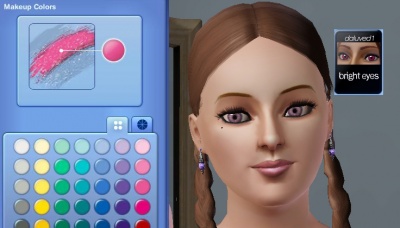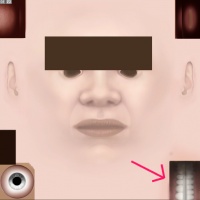| Tutorials by Category | |
|---|---|
|
CAS | Patterns | Objects | Building | Worlds | Modding | Modding Reference |
Contents |
Face Overlays
Face overlays are the common denominator to...well...all things face related in TS3. Using face overlays and the Cas Texture + Unitool (CTU), you can make:
- Eyeshadow, Eyeliner, Lipstick and Blush.
- Full-Face Costume Makeup
- Facial Hair (beards, eyebrows, etc.)
- Contact Lenses
- Non-Default Teeth
- Face Masks1
- Beauty Marks/Freckles2
And, the list grows longer as we get more creative. Basically, if you want something to show up on the face, then you'll need to make it as a face overlay.
Difficulty
Although the basic concepts of making face overlays is easy, making them well is another story. Some prior knowledge on using your image editor is required, as I will not be holding your hand as much as I usually do throughout this tutorial. Also, keep in mind there is no one-size-fits-all tutorial so you'll need to do a bit of extra tweaking here and there.
What You'll Need
- Adobe Photoshop (purchase) or GIMP 2.0 (free)
- The latest version of the CAS Texture + Unitool (CTU)
- DDS Plug-in for Photoshop or GIMP
- S3PE or Postal Package Editor (Optional)
(I'll be using Photoshop 7.0, so if you're using a different program the screen shots will be different but the concept is the same.)
Before We Start...
I always like to give a little background information before starting a tutorial.
Face overlays are similar to the base textures that are used for clothing. They are composed of two parts: the main texture image and an alpha channel.
The main texture should always be left grayscale, it's only pictured purple for emphasis. In fact, most of the textures for makeup and beauty marks/freckles are left a flat white or grey with no added texture.
When working with these it's best to Extract a CAS Part type that is similar to the area you want to work with. For example, if you want to make an eyeshadow then extract a preexisting eyeshadow overlay and edit it to your liking.
What Else?
In addition to the face overlay, to make your project complete you'll need to make a RGB Mask to go with it. You'd treat the mask just like you would with clothing, use it to map out the different tintable areas of your CAS part. With face overlays, you can only recolor them with tints (solid colors), no patterns can be used.
Also, you can add a custom Face Specular to your creation. The specular texture is what adds shininess to the CAS part. Although the specular is rarely changed, they could possibly be used to add glossiness and shine to lip-gloss if done right.
The Tutorial
Preliminary
Using the tool of your choice (CTU is the easiest) extract the face overlay of a CAS part you wish to edit.
Note: If you're using a package editor like S3PE or Postal, all of the CAS part textures can be found in FullBuild0.package.
Once you've found the texture you wish to use, open it up in the image editor of your choice. Remember do NOT tick generate Mipmaps when you import the .dds texture.
For sake of this tutorial, I'll be using the afMakeupBlushHighBasic texture found under Adult-Female-Makeup.
Editing
Step 1
When you have the texture loaded, switch over to the channels view and click on the alpha channel.
Step 2
Edit up the alpha texture to your liking, use the eraser and/or the paintbrush to add details and such. Remember that black areas on the alpha are not visible and white areas are fully opaque. Any shades of grey give an transparent/translucent effect to the texture; the darker the grey, the more transparent the texture and vice-versa.
Notice the gradient (smooth transition from light to dark) on the edges of the blush. You should always leave soft edges on your face overlay texture (especially when creating makeup). If the edges are too harsh, the makeup will look painted on and blocky, and unless that was the look you were going for, hard edges should be avoided at all costs.
Using the eraser tool, I'm going get rid of the top points of the blush. Notice how I created those harsh jagged edges. To remedy this, I'm going to use the blur tool to soften up the edges. The Gaussian Blur filter is also a good tool to get nice smooth edges.
Play around with the texture until you get a finished product that looks more or less like mine.
Step 3
Switch back over to the main texture view. Nine-times-out-of-ten the main texture is either a flat light grey or a grayscaled image surrounded by black. Just to show a concept I'm going to add a little heart design in the middle of my blush texture. The best way to line up the image is to have the alpha channel visible while editing. Remember to keep the texture greyscaled.
Step 4
When done editing, flatten your image as a .dds in DXT5 compression.
RGB Mask
After saving your overlay, it's a good time to go ahead and make a custom RGB Mask if you need to. If you haven't the slightest clue what a RGB Mask is, then follow the tutorial here.
Your finished mask should look similar to the one pictured.
Importing
Step 1
Import your Overlay file into the CTU and also add any other textures like RGB Masks and Speculars.
Step 2
Once you have all of your textures imported and committed, disable any unused tints. For example, my blush only has two recolorable parts so I'm going to leave Tints A&B set to "true", and C&D set to "false". Disabling tints isn't necessary but it makes your work look a lot more neater and polished, in my opinion.
Step 3
Change the default tint colors to whatever you wish by either double-clicking on the tint color, or double clicking on the little square at the bottom.
Step 4
Before saving, go to the Part Category tab and check/uncheck the categories as you see fit.
Step 5
Give your project a quick once over, then save your .package. This is how my blush came out, I would hope that yours would look better with practice. :)
Eyes/Teeth
Eyes and teeth are done a little bit different. You cannot directly create these with the CTU, so you'll have to export the amFaceEyeColor IMG file found in the FullBuild0.package with either S3PE or Postal.Eyes
Follow Aikea_Guniea's tutorial found here for more information on how to edit the eyes.
Once you're done editing you can either make them default replacement eyes by following the rest of Aikea's tutorial, or you can import the texture back into the CTU as a costume makeup to create recolorable contacts (pictured below).
Teeth
The same process used for eyes, is used for teeth as well, you just have to edit the "teeth section" on the amFaceEyeColor texture. And like the eyes, they can be made as both default and non-default by using Aikea's method or using the CTU respectively.
Tips/Tricks
- Remember that you can make more than make up with face overlays, you can make facial hair and topical details like scars and beauty marks as well.
- When making your alpha channel, consider using slight shades of grey to create a soft semi-transluecent effect. This'll keep your makeup and facial hair from looking too drawn on.
- The Gaussian Blur filter makes amazing makeup effects.
- When doing eyebrows, add lots of hair separation because the texture will get smushed together in game creating horrid solid chunks for eyebrows.
- For more help visit the Create-A-Sim section at MTS.
Notes
1 Face masks are handled differently so they will be discussed in a separate tutorial (coming soon).
2 Although you can make beauty marks using the methods above, if you wish to make them layerable and show up in the Topical Details section like the in-game EA beauty marks you'll have to clone an existing beauty mark and do some extra coding with S3PE/Postal. It's not *hard* to do per se, but it's a little tedious. See this thread for more information on how to manually create a non-default CAS part.
| Tutorials by Category | |
|---|---|
|
CAS | Patterns | Objects | Building | Worlds | Modding | Modding Reference |

 Sign in to Mod The Sims
Sign in to Mod The Sims